We do not recommend or support sites that have ecommerce integrated, such as woocommerce. The simple reason is that it creates too much complexity, is too difficult to support, and is not our focus as a company.
If you have woocommerce, you'll be better served at another theme company.
Jump to:
Why?
The first thing you need to know is that running an ecommerce business is entirely different than running a food blog.
Recipe queries (informational intent) do not convert to sales (purchase intent). Recipe traffic and product sales are totally unrelated traffic.
Recipe sites and ecommerce are two polar opposite business models and do not belong together, period.
How you design a website for ecommerce conversion optimization conflicts with how you design it for food blogs. Our themes are designed for running successful food blogs, not ecommerce businesses.
Shop pages
An alternative to installing woocommerce software on your website is to build a single "Shop" page, using basic columns, images and (affiliate) links.
However, even this is usually a waste of time:

I've personally had dozens of conversations with people who have had shop pages for years, and not one person has ever said it accounts for more than 2% of their revenue.
I learned that if you work hard and creatively, you can have just about anything you want, but not everything you want.
Ray Dalio
Why you shouldn't install Woocommerce
WooCommerce has as many gotcha's and issues in itself as WordPress as a whole. For every 10 blogs that setup WooCommerce, 9 will fail to make enough money to cover the headache of simply running it. Before you even set up your first product, you need to decide:
- How you'll protect your customer's sensitive data
- Which credit card processor you'll integrate with
- How you'll charge and collect taxes (this requires an accountant)
- How you'll handle book keeping (inventory is a MASSIVE headache)
- What your return policy is
- How you'll deal with chargebacks
- How you'll market the product
- What you're willing to spend on CAC (customer acquisition cost) vs. LTV (life-time value)
We don't recommend anyone set up WooCommerce until you can do it yourself, or afford to hire a developer to troubleshoot the issues for you (roughly: $1000/month).
Below that threshold, the effort involved in setting up and maintaining it is simply not worth it. It's not uncommon to spend over 100 hours before even making your first sale, and building real revenue out of that takes years of optimization.
And all of this is a distraction to actually running your food blog.
Alternatives
Instead, begin with simple affiliate programs and third-party fulfillment (eg. Amazon). The most common item to sell for food bloggers is a cookbook, and it's far better to use Amazon's services than to try to do it yourself.
If you're already set up with Paypal or a few other payment processors, you can actually create products and "Buy It Now" buttons right in the processor itself, and save yourself dozens of hours of headaches.
Other platforms that make it easy to sell digital products:
- Gumroad
- Teacheable (courses)
- Sellfy
- Payhip
- Convertkit
Dedicated ecommerce
Lastly, we recommend Shopify as a dedicated ecommerce channel.
The pace of innovation within Shopify means that their default setup will be 10x better than something you try to build yourself. At $10-$30/month it requires a small investment, but if you're struggling to justify $30/month, then you shouldn't even be thinking about launching an ecommerce store at all.
Successful example
I'm not going to pretend that it's not possible to do both a content site supported by ads, as well as a separate ecommerce site. The best example I know of is Susie from HeyGrillHey and her ecommerce site.
However, it's super important to realize that Susie absolutely nailed being a content creator and was in the top 0.1% of food blogs before she started her ecommerce. And the reason she was able to start the ecommerce site is because the niche she was in lent itself well to product creation, she had demand for the products, and she had a whole team to work on both the content and ecommerce.
Rather than being an example of how to do it, I'd label her the exception that proves that rule (that content sites and ecom don't mix well).
